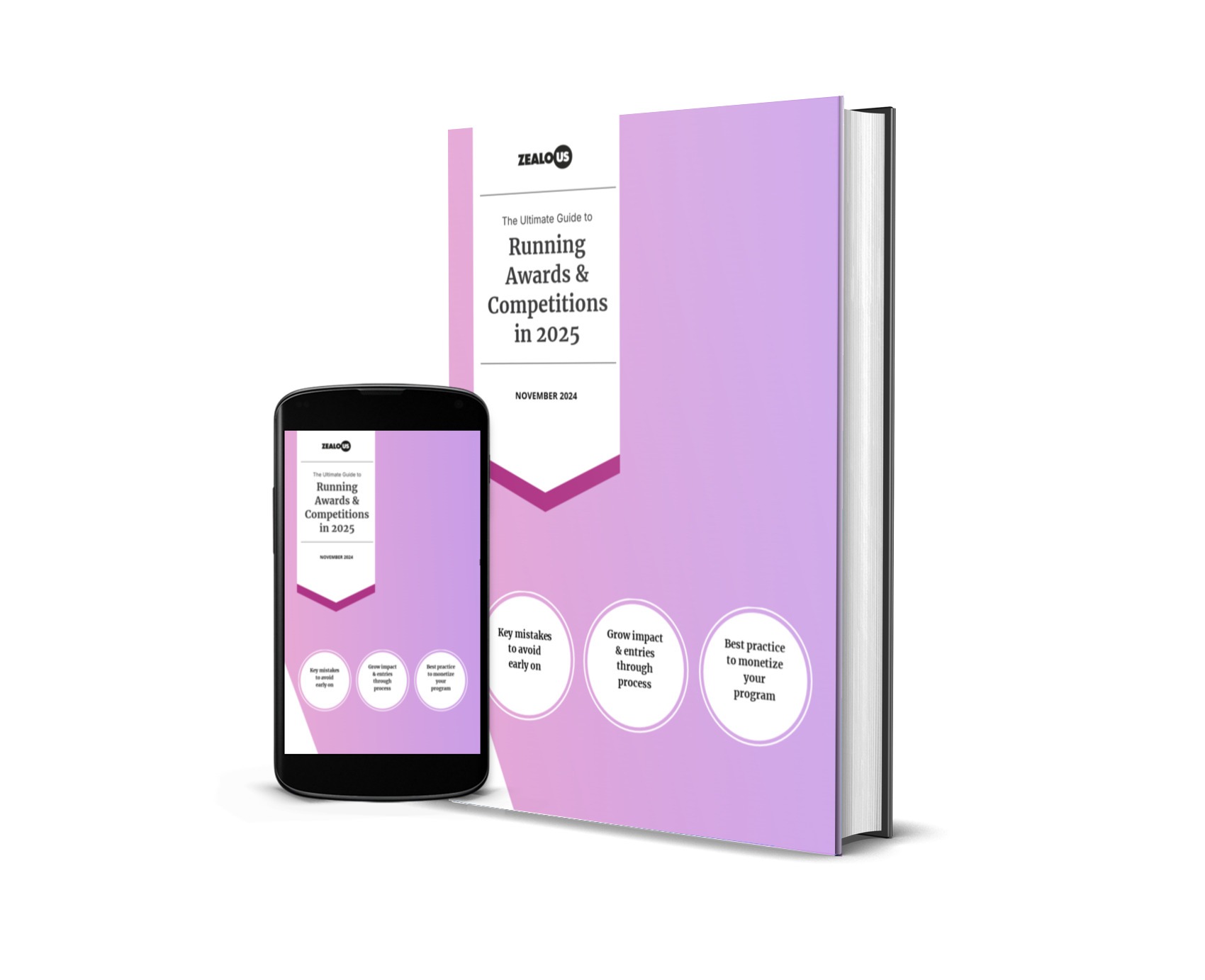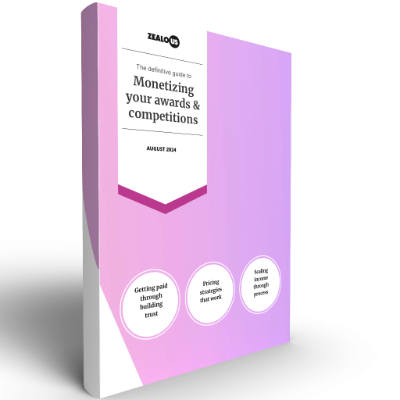This article covers:
- When manual processes work
- Simple judging doesn’t need software
- The time and patience factor
- One-time programmes
- When you’re not collecting entry fees
- Internal vs external applicants
- Professional image considerations
- When programmes have no growth plans
- Budget are very (very) tight)
- The real cost of going manual
- Warning signs you’ve outgrown spreadsheets
- Making the decision
You’ve just been told to run an awards programme. Your first thought? “Do I really need software for this?”
Maybe not.
Yes, we make awards management software. And no, we’re not about to hard-sell you something you don’t need. Because sometimes a form and a bit of elbow grease will do just fine.
You’re running a small programme that won’t scale
Let’s start with the obvious one.
If you’re managing five to 10 entries with three judges who all sit in the same office, you probably don’t need software. A shared spreadsheet, some email threads, and maybe a Google Form will get you there.
The sweet spot for going manual sits somewhere under 20 entries. Beyond that, things get messy fast.
The Tipping Point
At 20 entries, you’re spending roughly three hours per entry on admin (email candidates, download files, compile sheets…it adds up quickly). That’s 60 hours of manual work. If your time is worth £25 per hour, you’ve just invested £1,500 in labour that some software could have handled for less.
Manual processes don’t scale linearly. Managing 20 entries isn’t twice as hard as managing 10. It’s closer to four times harder when you factor in the coordination overhead, the increased chance of errors, and the mental load of keeping track of everything.
Your judging process is very simple
One category. One criterion. Three judges who need to just pick out their favourite. Done.
Spreadsheets work fine for basic voting methods like simple reviews, but anything more complicated can get messy very quickly.
If your evaluation doesn’t involve weighted criteria or blind judging across multiple rounds, you can probably manage without software. Send judges a shared doc, let them add their scores, calculate an average in Excel, and call it a day.
The moment someone says “Maybe we should weight technical merit differently to creativity?” you’re entering territory where spreadsheets become painful.
But watch out for scope creep. The moment someone suggests “Maybe we should weight technical merit differently to creativity?” or “Can we hide judge names from each other?”, you’re entering territory where spreadsheets become painful.
Criteria-based scoring systems, positional voting, or anything involving multiple evaluation stages? That’s when you’ll start wishing you’d invested in proper tools three weeks earlier (panic usually sets in 48 hours before your deadline when you realise you will get double the amount of entries you expected).
Download launch checklist
Never miss a critical step: 300+ tasks across 8 phases, from securing judges to winner announcement.
You have unlimited time and patience
Some people genuinely enjoy manual admin work, and are extremely good at it (I’m known for my spreadsheets, and I’m proud of it!).
If you find satisfaction in colour-coding spreadsheets, crafting individual email responses, and manually checking every submission against eligibility criteria, brilliant. You’re probably fine without software.
But be ready for your abilities to be stress tested. When you’re sending your 47th “Sorry, can you resubmit that with the correct file format?” email, the charm wears off.
Hidden Costs
Manual setups require juggling disparate systems, create possibilities for data entry errors, misplaced documents and miscommunication, with delays occurring as team members tackle repetitive tasks individually.
If two team members each spend five hours weekly on submission admin over a three-month programme cycle, that’s 120 hours. At £25/hour, you’ve spent £3,000 on tasks that could have been automated (and that’s not counting the emotional cost of any mitsakes made – and we all make them).
It’s a one-off
Running a one-time programme to celebrate your organisation’s anniversary? A single grant round with a tight scope? A memorial award that happens once?
Software might be overkill.
The calculation changes if there’s any chance of repetition. Even if you’re “probably” running it again next year, software pays for itself through the time saved on setup. Most platforms let you clone previous programmes, meaning your second year takes about 20 minutes to configure instead of starting from scratch.
One-off programmes only work manually when they’re also small. One-off programmes with 50+ entries? You’re better off with software even if you never use it again (ask yourself: is your sanity worth £900?).
You’re not collecting entry fees
No payment processing needed? That’s one less reason to need software.
Manual programmes work better when money isn’t changing hands. The moment you need to track payments, issue receipts, handle refunds, or manage different pricing tiers, spreadsheets become a compliance nightmare.
Payment Complexity
Payment processing alone can justify software costs. Manually reconciling who’s paid what, chasing late payments, and keeping financial records that satisfy your finance department creates surprising amounts of work.
Add in early bird pricing or group discounts and you’re building yourself a part-time job.
If you’re asking for optional donations rather than mandatory fees, you can probably manage manually. If you’re running different pricing tiers or need proper financial audit trails, you’re already past the point where spreadsheets made sense.
Want more articles like this?
Give this one a like
Your applicants are all internal
Running an internal recognition programme for your 30-person team? Everyone knows each other, submissions are informal, and the whole thing has a friendly vibe?
Spreadsheets are perfectly adequate.
Internal programmes have lower expectations for polish. Nobody minds if the submission process feels a bit rough around the edges when it’s just colleagues recognising each other’s work. The entry barrier is lower because people already trust your organisation and aren’t comparing your process to external competitions.
External applicants expect professional systems, clear communication, and transparent processes.
The moment you go external, expectations shift. When sending entries for evaluation to external expert panels, spreadsheets lack the vibe of a reputable awards programme. External applicants expect professional systems, clear communication, and transparent processes.
They’re investing time in your programme without the goodwill your colleagues bring. A clunky manual process signals either amateurism or lack of seriousness. Neither encourages quality submissions.
It’s not about looking professional
Some programmes genuinely don’t need to project prestige. A fun team award at your office party? Nobody expects slick systems. A casual creative challenge among friends? Equally fine.
But if you’re positioning your awards as industry-leading, seeking high-caliber submissions, or trying to build long-term credibility, your systems matter. They signal how seriously you take the programme and how seriously applicants should take submitting.
First Impressions Matter
Manual processes show. Applicants notice when they’re asked to email files instead of using a proper upload system. Judges notice when they’re working from shared spreadsheets instead of dedicated portals.
Everyone notices when communication is sporadic and inconsistent.
Your systems are part of your programme’s brand (whether you like it or not).
When growth isn’t the objective
If this year’s programme is identical to last year’s, which was identical to the year before, and you’re happy keeping it that way your existing manual processes can work indefinitely.
The trap is assuming things won’t change.
Most programmes experience gradual growth. You add one new category. Then another. Entry numbers creep up 15% year-on-year. Suddenly you need blind judging. Then someone suggests public voting. Before you know it, your simple programme has evolved into something complex, but you’re still using the same spreadsheet system from year one.
This is where things break. Not catastrophically. Just slowly with increasing amounts of stress each cycle. You know you should upgrade systems, but you’ve “made it work” for so long that the switch feels daunting (I get it, change is scary).
If there’s any chance your programme will grow or evolve, building on proper foundations saves future pain.
Insights like these straight to your inbox
Receive weekly tips from our founder to grow your program’s impact; regardless of what tools you use.
Budgets are (very) tight
This is the obvious one. You want put all your resources into celebrating the community you serve. You don’t think you can afford a platform since most of them are within the thousands (pounds/dollars) and they lock you into annual plans.
Yes you are right many platforms are very expensive, but not all (Zealous gives you 20 entries for free and have plans from £39/m which you can cancel at any time). But we know even that can sometimes feel out of budget. If you have time and very little money then spreadsheets can be a good option. Just be mindful the expense is going to be your time and effort.
The real cost of going manual
Manual processes hide their true cost.
Software has obvious upfront pricing. Manual processes accumulate costs in staff time, mistakes, missed opportunities, and stressed team members (are any of them working weekends to make it work?). These costs are real even if they don’t appear on your programme budget.
Calculate honestly: How many hours does your team spend on submission management, communication, coordination, and troubleshooting? What’s that time worth? Could you have spent these hours on something more valuable like increasingly your impact and reach?
Add in the cost of mistakes. Scores entered incorrectly. Emails sent to wrong recipients. Submissions lost because someone’s inbox was full. Each error costs time to fix and chips away at your programme’s credibility.
Software isn’t free, but neither is your time.
When manual processes start showing cracks
Watch for these warning signs that you’ve outgrown spreadsheets:
You’re spending more time troubleshooting admin issues than actually evaluating entries. Applicants email asking for submission confirmations because your manual system doesn’t send them. Judges complain about unclear scoring systems. You’ve accidentally notified the wrong person they won (hopefully you caught it before they posted on social media!).
Dropout Red Flag
If 40% of people who start your submission form don’t finish (and do you know?), your process is too painful. If judges are late with scores because they find your spreadsheet confusing, you’re creating unnecessary friction.
These issues typically surface around 25 to 30 entries. That’s when coordination overhead overwhelms the simplicity that made manual processes attractive in the first place.
Making the decision
So when DO you actually need software?
Here’s the rough framework: More than 20 entries? Probably time for software. Multiple rounds of judging? Definitely time. Complex scoring systems? Absolutely time. External applicants expecting professional systems? You needed software yesterday.
Under 20 entries, simple scoring, internal programme, one-off event? You can probably manage manually if you’re prepared for the work involved.
The honest answer is that software stops being optional somewhere between 15 and 30 entries, depending on your programme’s complexity and how much you value your team’s time and sanity.
Finally
We could tell you that everyone needs awards management software immediately. We could inflate the problems manual processes create or downplay how much work small programmes actually involve.
But that wouldn’t be honest, and it wouldn’t help you make the right decision for your specific situation.
Some programmes genuinely work fine manually. If yours is one of them, embrace it. Save the money. Put those resources toward better prizes or wider promotion instead.
But when you hit that tipping point where coordination overhead exceeds software costs, don’t let sunk cost fallacy keep you trapped in painful manual processes. Your future self will thank you for switching earlier rather than later.
We can help!
Zealous takes the pain out of running awards
But we’re not alone in the space – here are 8 others you may wish to consider (even if we would prefer you choose us!).
Want us to write more content like this? Give it a like
Share

Guy Armitage is the founder of Zealous and author of “Everyone is Creative“. He is on a mission to amplify the world’s creative potential.
Frequently Asked Questions
How many entries is too many for manual management?
The tipping point typically arrives between 15 and 30 entries, depending on your programme’s complexity. At 20 entries, you’re spending 60-80 hours on manual admin alone. If your judging process involves multiple rounds, weighted criteria, or blind judging, even 15 entries can overwhelm spreadsheet systems.
Can I manage judging with spreadsheets?
Simple judging with basic scoring and three judges can work with spreadsheets. However, the moment you need weighted criteria, normalised scoring, blind judging, or multiple evaluation rounds, spreadsheets become painfully inadequate. Judges also notice when they’re working from shared documents instead of dedicated portals.
What are the hidden costs of manual awards management?
Manual processes hide costs in staff time, mistakes, and missed opportunities. If two team members spend five hours weekly on submission admin over three months, that’s 120 hours or £3,000 at £25/hour. Add the cost of data entry errors, misplaced documents, and miscommunication, plus the emotional cost of preventable mistakes.
Is awards management software worth it for one-time programmes?
For genuinely one-off programmes with under 20 entries and simple judging, manual processes might suffice. However, one-off programmes with 50+ entries benefit from software even if you never use it again. The calculation changes entirely if there’s any chance of running the programme again, as most platforms let you clone previous programmes in minutes.
When does payment processing require dedicated software?
The moment you need to track payments, issue receipts, handle refunds, or manage different pricing tiers, spreadsheets become a compliance nightmare. Manually reconciling payments, chasing late fees, and maintaining financial records that satisfy finance departments creates surprising amounts of work. Early bird pricing or group discounts turn this into a part-time job.
What warning signs indicate I’ve outgrown spreadsheets?
Watch for spending more time troubleshooting admin issues than evaluating entries, applicants requesting submission confirmations your system doesn’t provide, judges complaining about unclear scoring systems, and high dropout rates (40%+ of starters not finishing). These issues typically emerge around 25-30 entries when coordination overhead overwhelms the simplicity of manual processes.
Can internal programmes work without awards software?
Internal recognition programmes for small teams can work with spreadsheets because expectations for polish are lower and entry barriers are reduced by existing trust. However, external programmes require professional systems, clear communication, and transparent processes. External applicants notice clunky manual processes and interpret them as signals of amateurism or lack of seriousness.









